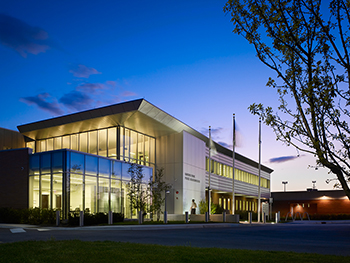Hanover Park Police Headquarters Receives AIA Award
 FAIRFAX, Va. — The Hanover Park police headquarters in Hanover Park, Ill., received high recognition this month by the AIA/JFR Justice Facilities Review Awards Program. The program documents best practices in planning and design for justice architecture, including sustainability and economic feasibility. The facility will be highlighted this fall in the 2014 Justice Facilities Review published by the AIA Academy of Architecture for Justice.
FAIRFAX, Va. — The Hanover Park police headquarters in Hanover Park, Ill., received high recognition this month by the AIA/JFR Justice Facilities Review Awards Program. The program documents best practices in planning and design for justice architecture, including sustainability and economic feasibility. The facility will be highlighted this fall in the 2014 Justice Facilities Review published by the AIA Academy of Architecture for Justice.
Although the Village of Hanover Park decided not to seek a LEED rating when the police headquarters opened in April 2012, the facility was built to LEED Gold standards and has been racking up a string of awards. Notable recognitions include the Excellence in Architecture Award for Distinguished Buildings from the AIA’s Northeast Illinois chapter; a Public Works Project of the Year Award from the American Public Works Association; and a Silver Medal for Design from the Association of Licensed Architects.
The $16 million complex designed by Fairfax-based Dewberry features an efficient “police triangle” layout that places patrol, detention and evidence processing in proximity to streamline operations and enhance security, according to Molly Wagner, director of communications for Dewberry.
The urban site promotes environmental innovations, including storm water detention with natural prairie planting bio-swales that promote natural groundwater filtration. Natural prairie grasses, Wagner said, act as filters for the oils, salts and grime from the parking surfaces before the water reenters the existing water system. This reduces the need for irrigation and erosion control.
At night, lights on the property are dark-sky compliant with zero foot-candles at the property lines, which prevents light pollution to adjacent properties.
During the day, an advanced daylighting control system, combined with energy-efficient lights, reduces energy consumption while maximizing natural day lighting. Materials throughout incorporate high-recycled content with low-VOC content, including the metal panels, carpeting, paint and structural steel. Ceramic frit glazing, exterior sun shades and sun blinds allow natural day lighting while reducing solar glare and heat gain.
“The building’s exterior was sensitively designed to relate to the rest of the municipal campus’s material language and consists of brick, precast concrete, metal panels, and glass,” said Wagner. “The north civic facades received the more premium finishes while the south service facades became more economical.”
One of the challenges of this project, Wagner said, is that the village board initially approved a 55,000-square-foot facility that didn’t include an enclosed parking garage or firing range due to budget limitations. Police leadership, however, maintained that these two items were important for the success of the project, as was choosing sustainable, high-quality materials.
“The challenge was to develop a strategy to fast-track the design and bidding process to take advantage of the bidding climate and focus on a construction that used durable, high-quality materials and finishes that were lower in cost in strategic locations,” Wagner said. “By utilizing these strategies and incorporating strategic alternate bids, the parking garage and firing range were both able to be incorporated into the original project budget meeting the Village’s financial goals and the police operational goals.”
Another challenge to the completion of the project was the bad soils at the onset of building excavation. This dilemma set back erection and enclosure by a month, pushing the project further into the winter months, during which happened to be the blizzard of 2011. It was also the rainiest spring in the last 30 years, Wagner said. However, by re-sequencing activities and project logistics, the project remained on schedule despite 30 days of weather delays.
The process was collaborative among all parties, Wagner noted. There was a strong commitment from both the mayor and board of trustees and a highly dedicated effort from the director of public works, as well as between the architectural team and the construction manager.
“As the Village’s mission is to provide responsive and effective municipal services toward the goal of maintaining a good quality of life for residents and businesses within the community, the new police headquarters is a strong foundation towards achieving that mission now and for many years to come,” she said.
